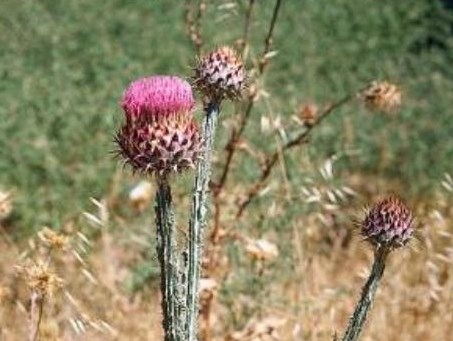Created by: Ramona Robison
Created on: Monday, Aug 8th, 2016
Created on: Monday, Aug 8th, 2016
Yes or No:
Yes
Points:
1
Confidence Level:
High
Answer / Justification:
Naturalized in California. Present in 2 counties according to Calflora. Also naturalized in Australia.
Reference(s):
Yes or No:
Yes
Points:
2
Confidence Level:
High
Answer / Justification:
Naturalized in California. Present in 2 counties according to Calflora. Also naturalized in Australia in areas which match California's climate.
Reference(s):
Yes or No:
Yes
Points:
2
Confidence Level:
High
Answer / Justification:
Considered invasive in Australia, details included in an Invasiveness Assessment and Impact Assessment prepared by the Victoria State Government.
Reference(s):
Yes or No:
Yes
Points:
3
Confidence Level:
High
Answer / Justification:
Considered invasive in Australia, details included in an Invasiveness Assessment and Impact Assessment prepared by the Victoria State Government. Is present in New South Wales in areas with climates which match California.
Reference(s):
Yes or No:
Yes
Points:
1
Confidence Level:
High
Answer / Justification:
Onopordum acanthium is also considered invasive in Australia in areas which match California's climate.
Reference(s):
Yes or No:
Yes
Points:
2
Confidence Level:
High
Answer / Justification:
O. illyricum points in GBIF for its native distribution in southern Europe as well as some of the points for Australia match California's climate.
Reference(s):
Yes or No:
Yes
Points:
1
Confidence Level:
Medium
Answer / Justification:
“Even when plants die, they usually remain standing for a long period of time and, by keeping the area bare of other vegetation, can maintain a niche for recruitment of the next generation.”
Reference(s):
Yes or No:
Yes
Points:
1
Confidence Level:
Medium
Answer / Justification:
Stems can persist into the next season with spiny phyllaries and receptacles attached. In dense patches, this dry matter may introduce a minor change to the frequency of fire risk.
Reference(s):
Yes or No:
Yes
Points:
1
Confidence Level:
Medium
Answer / Justification:
O. illyricum impacts grazing systems because it is spiny. Illyrian thistle tends not to be grazed by stock because of its dense spines. However, if the weed is grazed, the spines can cause damage, particularly around the mouths and eyes of animals.
Reference(s):
Yes or No:
Yes
Points:
1
Confidence Level:
High
Answer / Justification:
“Dense patches pose a physical barrier to humans.” The spiny nature of the plant is an annoyance to humans.
Reference(s):
Yes or No:
No
Points:
0
Confidence Level:
High
Answer / Justification:
Illyrian thistle's only method of dispersal is by seed which is equipped with a pappus of fine hairs and is spread by both wind and water.
Reference(s):
Yes or No:
No
Points:
0
Confidence Level:
High
Answer / Justification:
Illyrian thistle's only method of dispersal is by seed which is equipped with a pappus of fine hairs and is spread by both wind and water.
Reference(s):
Yes or No:
Yes
Points:
1
Confidence Level:
High
Answer / Justification:
Illyrian thistle's only method of dispersal is by seed which is equipped with a pappus of fine hairs and is spread by both wind and water.
Reference(s):
Yes or No:
Yes
Points:
1
Confidence Level:
Medium
Answer / Justification:
“A heavy seeder” 5 flower heads per plant x 200 seeds per flower = 1,000 seeds per plant (Estimate using pic. & illustrations)
Reference(s):
Yes or No:
No
Points:
0
Confidence Level:
High
Answer / Justification:
Illyrian thistle seeds have an initial short-term innate dormancy, following which the majority of seeds acquire induced dormancy, rendering them incapable of immediate germination.
Reference(s):
Yes or No:
Yes
Points:
1
Confidence Level:
High
Answer / Justification:
Some O. illyricum plants flower in the first year, others in the second year.
Reference(s):
Yes or No:
No
Points:
0
Confidence Level:
Medium
Answer / Justification:
In Austraila, Illyrian thistle flowers for three months and produces seed for 3 months.
Reference(s):
Yes or No:
Yes
Points:
1
Confidence Level:
High
Answer / Justification:
The pappus of the seed attaches to wool, vehicles, clothing, etc. or it can be a contaminant in hay.
Reference(s):
Yes or No:
Yes
Points:
1
Confidence Level:
High
Answer / Justification:
Illyrian thistle's only method of dispersal is by seed which is equipped with a pappus of fine hairs and is spread by both wind and water.
Reference(s):
Yes or No:
Yes
Points:
1
Confidence Level:
High
Answer / Justification:
The pappus of the seed attaches to wool, vehicles, clothing, etc or it can be a contaminant in hay.
Reference(s):
Queensland Government: http://keyserver.lucidcentral.org/weeds/data/media/Html/onopordum_acanth...
GBIF: http://www.gbif.org/species/3094910
Victorian WRA: http://vro.agriculture.vic.gov.au/dpi/vro/vrosite.nsf/pages/weeds_herbs_...
Agriculture Victoria: http://agriculture.vic.gov.au/agriculture/pests-diseases-and-weeds/weeds...
Reviewed by Gina Darin.
- < 13 : accept (low risk of invasiveness)
- 13 - 15 : evaluate further
- > 15 : reject (high risk of invasiveness)
PRE Score:
21
Number of questions answered:
20
Screener Confidence (%):
75.0
Organization:
Evaluation visibility:
Public - accessible to all site users

